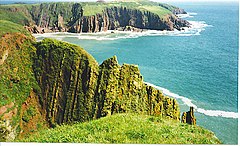Caldey
Caldey Island
|
|
|---|---|
 The south coast of Caldey Island |
|
| Caldey Island shown within Pembrokeshire | |
| Population | 40 (2011) |
| Principal area | |
| Ceremonial county | |
| Country | Wales |
| Sovereign state | United Kingdom |
| Post town | TENBY |
| Postcode district | SA70 |
| Dialling code | 01834 |
| Police | Dyfed-Powys |
| Fire | Mid and West Wales |
| Ambulance | Welsh |
| EU Parliament | Wales |
| Welsh Assembly | |
Caldey (Welsh:Ynys Bŷr) is a small island off the SW coast of mainland Wales, near Tenby in Pembrokeshire. With a recorded history going back over 1500 years, it is known as one of Holy Islands of Britain, and a number of traditions inherited from Celtic times are observed by the Cistercian monks who are the chief inhabitants and owners of the island today.
At its closest point, Caldey lies 1 kilometre (0.6 mi) south of the mainland, though the usual access to the island is by small boat from the town of Tenby which is some 4 kilometres (2.5 mi) to the north.
The island's population consists of 40 permanent residents and a varying number of Cistercian monks, known as Trappists, whose predecessors migrated there from Belgium in the early 20th century, taking over from Anglican Benedictines who had bought the island in 1906 and built the extant monastery and abbey but later got into financial difficulties. Today the monks farm the island, chiefly raising dairy cattle, and make a range of items including cheese, shortbread, perfumes and toiletries.
In the spring and summer, visitors are ferried to Caldey, not only to visit the sacred sanctuary but also to view the island's rich wildlife.
The island was named Ynys Bŷr for Saint Pyr, the sixth century saint, and Pyr is named as abbot of the monastery around the year 500 in the Life of St Samson. This Welsh name has remained in use since Medieval times, but the Old Welsh name of the island before St Pyr's day is unknown.
Like many Welsh islands, Caldey's (sometimes spelled Caldy) English name derives from the Vikings. Kald ey translates as "cold island", with the name appearing as 'Caldea' in the early 12th century, and Kaldey or Caldey by 1291.
A Celtic monastery was first established on the island in the sixth century, and the island thrived during the Middle Ages. Following the Norman Conquest, Robert fitz Martin, Lord of Cemais, gave the island to his mother Geva. In the 12th century, a priory was established there by Tironensian monks as a daughter house of St. Dogmaels Abbey, and lasted to the Dissolution of the Monasteries in 1536. The current abbey was built in 1910 by Anglican Benedictine monks but financial problems beginning in 1925 led to the 1929 purchase of the property by Belgian Cistercians. It is considered to be the most complete example of the Arts and Crafts style in the country, and was the largest project of John Coates Carter. At the time of building, the abbey was called "the greatest phenomenon in the Anglican community at the present time". The roofs are of white roughcast with red tiling, and the abbey church has five side-windows and on the south a "tapering" tower with primitive crenellations. Caldey Island and Little Caldey Island has been an ecclesiastical district for as long as the locals can remember, with 20 Cistercian monks living at the monastery as of 2007[update]. The Census Reports of the County of Pembroke record it as an ecclesiastical district for administrative purposes.
...
Wikipedia

